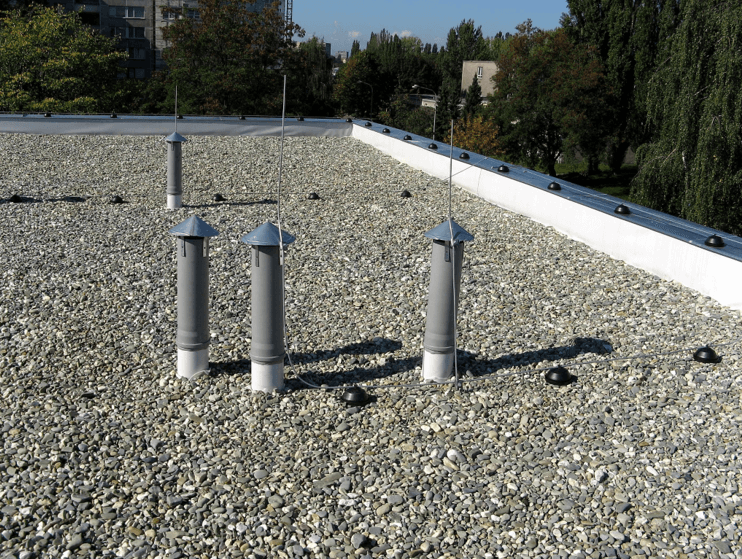If you need a new roof for your business, you have a lot of options at your disposal, but you need to consider them carefully. A new roof is a significant investment, and it can also be a major problem if you make the wrong choice.
In this guide, you’ll learn about some of the roofs that are available, and what it means to choose each one.
- Built-Up Roofing (BUR) Membrane
- Metal Roofing
- Shingle Roofing
- Spray-On Silicone
- Thermoplastic PVC & TPO Roof Membrane
Types of commercial roofing
Below, you’ll learn about five of the most common types of roofing that are available for businesses. For each one, you’ll learn the features, advantages, and why they are chosen for businesses like yours.
Built-Up Roofing (BUR) Membrane

Image by Paolo Neo of Pixnio
A built-up roofing membrane is formed of layers. It is referred to as a “tar and gravel” roof because tar and gravel form some of the layers. Other materials, including reinforcing fabrics, may also be used to prolong the lifespan of a BUR roof.
The protection that this roof offers is determined by the number of layers that are used to create the membrane. Using fewer layers means lower costs, but it also means a shorter lifespan and less protection from the elements.
The advantage of this roof is that the costs are generally low overall. Even the most comprehensive membrane created using this method will cost less than some of the other roofs on this list.
Built-up roofing is typically used for flat/low slope roofs. For that reason, beauty is not often a concern. These roofs are typically colored by the final layer that is used or painted white to reflect more sunlight and lower indoor cooling costs.
Metal Roofing
Image from Wikimedia Commons
Commercial metal roofing is made from exposed metal panels that are fastened together to form a protective layer. They may be made from different types of metals, though steel and aluminum are the most common.
Metal roofing is one of the most expensive options. However, this type of roof comes with many features that can help soften the blow of the high upfront costs. Metal roofing panels are significantly resistant to high winds and moisture.
The advantage of metal roofing is that it can last for decades with only minor amounts of maintenance. Metal roofs can easily last for 60 years, even in areas with harsh weather.
Metal roofing works well on almost any roof shape. The panels that are used can be custom-sized to fit most inclines or slopes. Metal panels can also be produced in almost any color.
Shingle Roofing
Shingles are one of the most common roofing materials. They are widely used on both residential and commercial roofs.
Though this material has a long history, it is not considered to be outdated at all, and it remains one of the best affordable options for steep-sloped roofs on any building.
A lot of features keep shingles popular. Depending on the materials used, they offer effective insulation, fire resistance, and weatherproofing. Many of the benefits of shingles depend on choosing the right ones. There is a significant amount of difference between the lowest and highest-quality shingles.
The advantages of shingles include low initial costs and relatively cheap maintenance. While shingles can be vulnerable to bad weather, making spot repairs is also low-cost compared to many other roofing materials.
Shingles are available in a great number of colors and styles. They can be cut in a particular way to match the look you want for your building
Spray-On Silicone/Spray Polyurethane Foam (SPF)
Spray-on Silicone and Spray Polyurethane Foam (SPF) are roofing materials that are sprayed in liquid form. The liquid hardens as it cools, and creates a solid layer.
These are not roofing systems on their own. Instead, they’re treatments that can be applied to an existing roofing system to renew the protection or to seal up cracks that have formed because of poor maintenance.
Spray-on roofing can be highly effective at managing the elements. Depending on the type of spray you select, it may have waterproofing and even insulating properties.
This is an effective option when the underlying roof is still in solid condition, but nearing the end of its warranty. It is most effective on roofs with a very low slope so that the spray doesn’t travel while it’s drying.
Thermoset EPDM Membranes
Image in Public Domain on Wikimedia
Thermoset EPDM Membranes are rubber roofing systems. EPDM stands for Ethylene Propylene Diene Terpolymer — the type of rubber that is used to provide the features that this roofing is known for.
Thermoset provides durable roof protection. It is resistant to ultraviolet light, some acids, and strong cleaning chemicals. It is easy to install because it’s just unrolled and then sealed into place. These rolls are single-ply, so they’re also easy to install. When sections become damaged, they can be cut out and replaced with ease.
These membranes are designed for use on flat or low-slope roofs. Though they provide excellent protection, they are not very attractive when visible from the ground. The rolls are available in white or black. White rollers can reflect light well, decreasing cooling costs on buildings where they’ve been installed.
Choose the right commercial roofing
You have a world of options to choose from if you want a durable, attractive roof for your commercial business. The right choice for you may depend on the type of business you’re running, the climate you’re in, or the kind of pressure that it needs to bear.
Make sure you consider all the options that are available, such as a BUR roof, metal roof, shingle solution, or membrane. Each choice comes with its own advantages, and any one of them could be the right one for you.
Featured Image by shutterstock.com